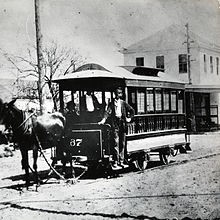If you lived in Greenville in the 1890s, you might have caught a ride in the new form of public transportation, the trolley. Often called a Horse Car, it probably was really a trolley drawn by a mule, the animal with more stamina and strength than a horse. Officially operated as the City Street Railway Company of Greenville, Texas, it operated briefly from late 1880s until the height of the 1893-1897 economic depression.
In March 1890 May W. G. Perkins and County Surveyor J. H. Morgan approved the route of the new trolley. Beginning at the Cotton Belt Depot at the bottom of East Lee Street, the line went up the hill to the Courthouse Square. There it turned south on Johnson Street, then west on Washington Street, before turning south again on St. John Street. The route allowed mules to avoid congested business traffic on Lee and Stonewall Streets as well as prevent rail tracks in the streets.
The trolley continued south on St. John to Oneal where it turned east to Moulton Street, again avoiding the exclusive housing development along Park Avenue, as the street was then named. At Moulton Street the trolley turned east again to Moulton Park, one of the early public parks in town. Baseball diamonds, a pavilion complete with a stage and a wooded area enticed visitors.
The first owner or at least major investor of City Street Railway Company was Judge M. M. Brooks. On December 18, 1888 Brooks sold his interest in the investment to Will N. Harrison. At the time, the route only passed through downtown and then south on St. John Street to Oneal. It was later expanded to the original plan. The trolley driver collected fares as well as steering the mule along the route.
A decisive economic depression in 1893 caused by overgrowth of the railroad industry led much of the United States to cease new investments and return to a more scale backed economy. The City Street Railway Company of Greenville became one of numerous victims. It folded not long after the economy failed, and long before it returned in 1897.
In 1910 the first electric street railway line served Greenville until 1916. All were part of the national trend to introduce and establish an urban transportation system. Have you noticed that the subject occasionally rears its head, even in the 21st Century?

